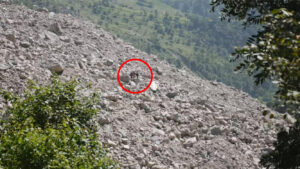One of the most misunderstood concepts in circulation is the belief that there exists a universal balance of power that entitles you to deserve and will give you the opportunity to make a new attempt. WRONG! In this article, which will open your eyes, Sweden’s foremost high-altitude climber and esteemed lecturer Fredrik Sträng problematizes a phenomenon that can ruin your chances of reaching your dream goal if you don’t get moving because opportunities rarely knock on the door twice.
“Don’t start living tomorrow because tomorrow never arrives.” – Johann Wolfgang von Goethe
Having doubt as a life philosophy is like having immobility as a mode of transportation.
It has happened that I have “failed” to climb 8000 m mountains in the Himalayas due to ominous weather, and people always comment: “The mountain remains, you can come back.” They mean well, but the advice has always rubbed me the wrong way. It has a connotation that isn’t logical. Mount Everest (8848 m) grows by approximately 1 centimeter annually and will stand for eons. But as a Swedish man, I will exist for 80.3 years if one is to believe the life expectancy according to Statistics Bureau of Sweden (for the record, I plan to live considerably longer). Do I really have time to come back?
Out of the 80.3 years that I wander on this planet, my absolute “peak” in terms of strength and endurance lies in the age range of 30-45 years. With the right training, a healthy diet, effective recovery, and staying injury-free, I can extend my active career to around 55 years of age. This gives me, at best, 25 years where I can be a “peak performer” and challenge the most formidable and prestigious mountains in the world. It takes roughly ten months to train for a large-scale Himalayan expedition. This gives me, at best, one valiant attempt per year. Then it costs a fortune to climb these giants, which reduces the number of expeditions I can realistically embark on during my time on Earth. Considering these values, perhaps there will be ten actual attempts in a lifetime. Ten attempts to achieve greatness.
Several of these attempts can easily fail due to ferocious weather, which makes a safe ascent impossible. Geopolitical instability can also cause problems for the climb, as happened in Nepal in 2006 when King Gyanendra Shah was forced to relinquish power and civil war followed. Now we are down to 6-7 attempts with potential for success.
Imagine then that you stand as I did in 2005, 240 meters from the top of my dream goal, Mount Everest, and are forced to turn back because the oxygen isn’t working and you have a throat infection and fever. The summit is tempting, but here the risk/reward alarm must sound. And it did for me. The decision to descend was one of the easiest decisions of my life (more on that in a later article). But not listening to the signals or seizing the opportunities when they arise can cost you much regret and in my case as a climber, missing out on my childhood dream coming true, or worse, sudden death.
So, what can we learn from the Himalayan performance philosophy?
Decide what you are going to do and do it until proven otherwise. Trust me, you don’t have enough time in life to wander around and hesitate if you are going to achieve greatness. You must take action. Let each attempt be like your last but do not put your life at risk.
“Why didn’t I invest 1 SEK in Bitcoin in 2009!? Then I would have been, uh, filthy rich today!!
The transaction that initially gave Bitcoin a monetary value took place in October 2009 when Finnish computer science student Martti Malmi, known online as ‘Sirius’, sold 5,050 BTC (Bitcoin) for $5.02, giving each Bitcoin a value of $0.0009. Bitcoin’s all-time-high (ATH) was recorded in early March 2024 at a value of $73,000/BTC. An astonishing increase of 8.1 billion percent. And all within the span of fourteen years. The overwhelmingly largest appreciation of an asset in world history.
If you had listened to the rumours in 2009 about this groundbreaking technology called ‘blockchain’ and the so-called ‘digital gold’ Bitcoin, which in a simplistic manner is a bank in cyberspace, driven by incorruptible software, and offering a global, affordable, simple, and secure savings account to billions of people who do not have the ability or desire to run their own hedge fund, you would be home free now. Your 1 SEK in Bitcoin would today be worth 80.7 MSEK.
Imagine that you were curious the first time you heard about Bitcoin, this decentralized digital currency, which simply explained, works as follows:
Money is a tool for moving value through time and space.
Gold was good for moving value through time but not space.
Fiat currencies are good for moving value through space but not time.
Bitcoin is optimized for moving value through both time and space.
But you, like me, were probably too busy going to work every day and earning ‘real money,’ keeping the body in shape, thinking about what to buy for food, and at best making sure that your pension savings yield 3-4% annually, instead of listening to a bunch of computer nerds playing with pretend money over the internet. Bitcoin is surely a fad just like the misquoted Minister of Communications Ines Uusmann (S) expressed, that “the internet is just a fad.” What she said was, “…I don’t think people in the long run will want to spend as much time, as it actually takes, surfing the net.” And because we chose to spend our time on other things, we missed the Bitcoin train. But is the race over?
The adoption of Bitcoin is still in its infancy, and both countries, financial institutions, billionaires, and Fortune 500 companies are diversifying their portfolios with Bitcoin. Some believe that Bitcoin will surpass the market value of gold in the foreseeable future, which would correspond to a price per Bitcoin of $650,000.
What often guides our decisions is our heuristic. Heuristic is a term used in psychology and cognitive science to describe a mental shortcut or rule-based strategy used to make quick and efficient decisions and solve problems. It’s a kind of “rule of thumb” or strategy that people use when faced with complex decision situations or problems, often with limited time or information. Heuristic can be useful for simplifying decision-making, for example, choosing a restaurant, but it can also lead to systematic mistakes or biases in reasoning, such as investments.
Many probably chose to forgo Bitcoin because it seemed complicated, corrupt, and more recently, it has also been stigmatized as energy-intensive (According to a recent report from Bitcoin ESG Forecast, the use of sustainable energy in Bitcoin mining has reached a record level of 54.5%).
Bitcoin simply wasn’t something we could “touch,” let alone understand, so instead of giving it an honest chance and doing our research, we continued to go to work to earn “real money.” Hindsight is easy. It’s easy to sit in the stands and criticize both players and referees on the field, but as skiing legend Thomas Wassberg once said, “Go ahead and do it yourself if you think it’s so damn easy!”
So, what can we learn from the Bitcoin miracle and above all about our approach to unknown phenomena?
You have two ears and one mouth. Use your ears more than your mouth. Gather relevant information, be curious, have a critical eye and an open mind. Don’t dismiss anything with the excuse that you don’t have the energy or time to delve into the subject. Investing always entails financial risk, but not taking any risks at all will not yield any gains.
So many times, I am subject to “the death wish” as a climber by people who lack the energy to understand my driving force. If suicide were the goal, then I am really bad at killing myself! It’s not a near-death experience that I, as a climber, am after. It’s a near-life experience! The challenge is that we are too lazy to delve into new trends and patterns. Most people automatically seek the path of least resistance. Therefore, it’s easy for us to miss the train and misinterpret our surroundings. Do your ‘due diligence’. Do your thorough research and then make a decision.
“I don’t have time to exercise!” The worst excuse I know!
If there is fairness and solace in the world, it’s that we all have 24 hours in a day. And there’s an old saying that if you want to get something done, you should ask the person who has many irons in the fire because they know how to manage their time efficiently. I get frustrated when I hear people complaining that there’s not enough time. If you repeat something enough times, it eventually becomes truth.
In a week, you have 168 hours to allocate. According to the latest research, the advice is 8-9 hours of sleep per day. Let’s assume you get 8 hours of sleep/day, which is 56 hours/week. Then you dutifully work 8 hours a day, resulting in a 40-hour workweek. Then you commute between work and home, which takes 1.5 hours daily, amounting to 7.5 hours/week. Let’s say cooking and eating take up 2 hours daily, which is 14 hours/week. Cleaning, laundry, dishes take 3.5 hours per week, and taking care of your children takes 2 hours/day, which is 14 hours/week. Grocery shopping takes 3 hours every week, and you enjoy scrolling on your phone and watching TV, which you do for a total of 2 hours daily. Showering and bathroom activities take 3 hours/week. You now have 13 hours left every week. What do you do with the remaining hours? Meditate? Rest? Exercise?
“There’s just not enough time!”
Do yourself a favor to put an end to this theory that plagues the majority of people worldwide. The experiment takes one week. Clock everything you do and jot it down in a notebook that you always carry with you. Then input everything you’ve done and the time it took into an Excel sheet. Now you have a receipt of what’s eating up your time.
People who complain about not having time to exercise have misplaced priorities in life. Exercise prolongs life, keeps your brain sharp, reduces the risk of illness, and boosts self-confidence. So if you want to perform better at work, be there for your children, and look forward to a vibrant retirement, then you need to exercise. The excuse of not having time to exercise is of the same breed as complaining about the unbearable winters in Sweden. To them, I say, move to warmer climates if snow is such a nuisance during the winter months!
So, what can we learn from the time we have?
There’s plenty of time for you to accomplish what you love. It’s about identifying time thieves and reinforcing better routines without rushing. Rarely is our map the reality when it comes to allocating our time.
In summary: The mountain won’t remain. It will disappear after hundreds of millions of years. You definitely won’t remain. Your lifespan is just a breath on the cosmic timeline. Respect your time and others’ time, and be grateful when someone shares their time with you. It’s among the finest things there is. I actually believe that the one who has the most time wins in the end. That person has chosen to forego the unnecessary and focus on what creates energy and brings well-being. Remember that you might only get one shot in life for a test, an exam, a job, or a mountain.
Make it count!
Footnote: Fredrik climbed Mount Everest in 2006.
Note: No financial advice.
About Fredrik Sträng: Fredrik, in his leadership role, has climbed seven of the Earth’s fourteen 8,000m peaks, set a Guinness World Record, and lectures on leadership, communication, decision-making, and crisis management.
Sincerely
Fredrik Sträng
Alpinist – Speaker – Coach







